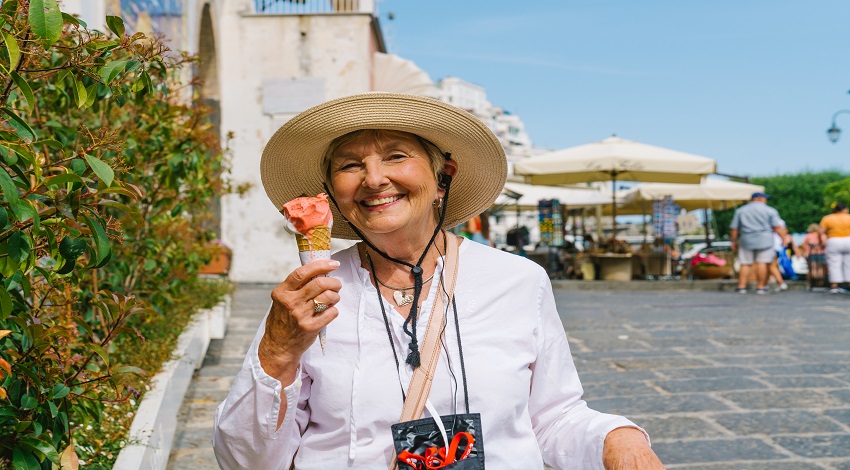Beat the Heat: How to Stay Cool When Traveling
When you embark on a summer learning adventure, the heat is almost always a top factor to consider before and during your travels. Heat-related illnesses, such as heat stroke and heat exhaustion, can be very real and scary, but fortunately, they can also be avoided with the proper precautions. Here are five of our tips for staying cool and protecting yourself on an adventure during the heat of the summer.

1. Hydration is Key
Staying cool and hydrating are the two most important things you can do to avoid feeling sick and discomfort when it’s extremely hot. Make sure to have water on hand at all times. Pack a reusable water bottle as some countries such as Spain and France have banned certain single-use plastics to help reduce plastic waste. If you can, put ice cubes in your water bottle, or refrigerate overnight before you head outdoors. According to the Red Cross, the average person needs to drink three-quarters of a gallon of water each day. It’s important to keep drinking even when you don’t feel thirsty.
· Avoid sugary, caffeinated and alcoholic drinks. If you are sweating a lot, combine water with snacks or a sports drink to replace the salt and minerals you lose in sweat.
· Think small and savory when it comes to meal or snack time. But no need to miss out on the local culinary delights! For example, if you're in Europe, treat yourself to thirst quenchers like a refreshing insalata caprese, frosty lemon gelato, watermelon and feta or chilled gazpacho.

2. Keep Your Cool
· Spritz or splash with a mist of cool or room-temperature water.
· Some hotel rooms in other countries don’t have air conditioning. If your hotel doesn’t have A.C., keep windows open at night and check with the hotel operators to make sure there are fans to circulate the air.
· Avoid strenuous exercise outdoors if possible.
· Try cooling it with a hand-held fan, a convenient way to escape the sweltering heat while you’re on the go.
· Seek out shade, and opt for lightweight, breathable fabrics like cotton or linen. Caution: bare arms and legs run a higher risk of sunburn.
· Head indoors: Try to avoid excursions during the hottest part of the day. Consider museums, restaurants and other air-conditioned places your best friends for cooling off. Try to limit your wanderings to the early morning hours, before 10 a.m., or after the sun has set.
· Take a mid-afternoon siesta!
3. Take the Heat Off Travel Nerves with Road Scholar’s Help
Our local experts guiding your adventure will also have frontline experience and their own advice to help you beat the heat. If you do become ill and need medical assistance they will help find local medical care.
The Road Scholar Assurance Plan provides coverage in the event of a medical emergency. It is purchased on behalf of every participant and paid for by Road Scholar. The plan provides 24-hour assistance in the event of a medical emergency during your program and insurance for emergency medical evacuation. Learn more on our website about this great benefit provided to all Road Scholar participants.

4. Keep Ahead of Heat-Related Illnesses.
Heat-related illnesses are preventable. The Centers for Disease Control (CDC) offers this advice for what to look for and what to do if you or a loved one shows signs of having a heat-related illness:
· Dehydration: Signs of dehydration or heat exhaustion include dizziness, lightheadedness, headache, a racing heart or feeling lethargic. Low energy — if someone is not talking or interacting as much as usual — is especially important to watch out for in people with cognitive impairment, who may not realize how hot they are or be able to express it.
· Heat exhaustion: Symptoms include heavy sweating; cold, pale and clammy skin; a fast, weak pulse; nausea or vomiting; muscle cramps; fatigue; dizziness; or headaches and fainting. If you are experiencing these symptoms, sip water, move to a cooler location if possible, loosen your clothes, or try to take a cool bath or place cool, wet clothes on your body. Seek medical attention immediately if you vomit or if your symptoms worsen or last longer than an hour.
· Heat stroke: The symptoms of heat stroke include a high body temperature (103°F or higher); hot, red, dry or damp skin; a fast and strong pulse; a headache; dizziness; nausea; confusion and passing out. If someone is experiencing these symptoms, call 911 immediately, and try to move the person into the shade or a cooler area if available.
5. Take the Temperature of Your Locale.
Use a weather app to stay informed about the temperature or intensity of ultraviolet (UV) radiation where you are. This tool is easily accessible on weather apps like Dark Sky and provides real-time updates on UV levels, helping you make informed decisions about sun exposure and when to wear sunscreen.
